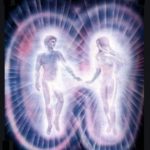Yin & Yang: A Complementary Balance

Yin & Yang: A Complementary Balance
by Diana Daffner
Mars was the Roman god of war; Venus was the goddess of love.
Men and women are often seen as opposites, but I prefer to think of us as a pair.
Pairs are in relationship with one another. The concept of pairs appears in almost all human stories, myths, and spiritual literature. Everyone is familiar with Adam and Eve and the later two-by-two boarding of Noah’s ark.
Our lives are filled with paired opposites or complementary qualities, such as giving/receiving, day/night, fire/water, inside/outside, slow/fast, wet/dry, earth/sky.
All of these are embraced and explained within the classic philosophy of yin and yang.
A Story of Yin and Yang
Long ago, ancient Chinese philosophers observed and studied the ebb and flow, the increase and decline of nature in all of her magnificent manifestations. They saw that each morning the sun rose in the east, casting its brilliant light upon the landscape. They noticed, however, that only the side of a mountain facing the rising sun could receive the morning light. They called this sunny side of the mountain ‘yang.’
The name they gave to the side of the mountain still in darkness was ‘yin.’
Even as the rest of earth became visible, the yin remained shrouded in darkness, its features unexposed, hidden from sight.
Yang stood out bright and clear, visible to whomever wanted to see what was going on. While yang awakened to the sun’s warmth, heating up from the tops of trees down to the roots in the ground, yin remained cool with nighttime dampness.
On the yang side of the mountain, leaves unfurled and turned toward the sun, drying off as they reached outward toward the light.
On the yin side of the mountain, leaves and flowers remained folded in upon themselves, perhaps gathering strength or seeking an inward comfort.
There was great stirring and much movement to be seen on the yang side of the mountain, as animals awakened, stretched, and began their day. On the yin side, there was less activity, less movement, a pervasive hush across the land.
Yang continued to warm up, not just absorbing the sun’s radiation, but also giving off its own heat, the heat of life, the passion of the hunt. The inhabitants, both human and animal, could be seen searching for food to bring the fire of life into their bellies and heat up their primal drives.
All the while, except perhaps for some night-prowlers and night-blooming flowers, the yin side remained quiet and still, unseen.
The ancients continued to observe and saw that this great distinction between the sunny side of the mountain and the shady side of the mountain was a temporary condition. As the sun reached its zenith and began to descend toward the western horizon, that which had been in darkness now became bathed in light, and that which had been brightened was now receding into a dim obscurity.
What had been yin was becoming yang, and vice versa.
What had been the sunny side of the mountain was turning into darkness. What had been hidden on the shady side was now revealed by light. The yang activity was closing down into the stillness of yin. What had been yin was expanding and awakening into the brightness of yang.
The ancients looked beyond the mountain and concluded that the entire nature of the universe could be described in terms of these two ever-changing principles: yin and yang.
They began to assign characteristics to these two aspects of life, to apply the principles of yin and yang to all of the observable qualities in the universe.
They described yang in terms of its brightness, its outwardly moving energy.
Yang came to represent various aspects of light.
That which seemed dark was called yin.
Yang was warm and dry; yin was cool and moist.
Yang was associated with all that was visible, the activities of daytime, the paths that could be seen to be going somewhere.
Without light, the world of yin was considered secretive, less direct, more turned in upon itself.
The ancients looked at our human bodies and saw that male sexual organs were visible and outwardly protruding. Female genitals were hidden, recessed, mysterious, and dark. Gender qualities were added to the growing catalog of what was yang and what was yin. Yang was labeled masculine and yin became the domain of the feminine.
In the cultural climate of ancient China, men were the doers, the hunters and warriors, the adventurers, the aggressors. Women stayed together, close to their shelters, were less assertive, and had children to care for and nourish.
Yin came to represent that which is caring and compassionate, connected to others. Male relationships were more task-oriented, often competitive. Leadership was understood to be yang, embodied in the bodies of men. Women were described as yin, mysterious and modest.
Women may have wielded power, but they had to sit behind a screen when speaking in public. They were not permitted to be seen by men, other than their husband. They were not allowed to stand in the daylight and direct the affairs of humanity.
Times have changed. Women have come out from behind the screen. Some of us women are clearly as aggressive as men. Women can wrestle and kickbox. While some women are stay-at-home moms, others are heads of states and corporations, and still others manage to do an amazing balancing act.
It is acceptable today for men to stay home to care for children, and it has become acceptable—and maybe even expected—for them to be sensitive and affectionate. Men are not limited to playing out the yang role any more than women must remain demure and modest.
Yet the emotional yearning for deep intimate bonding with another human being can still be considered a yin attribute, whether recognized in the heart of a man or a woman.
The physical desire for sexual release, the driving force of physical attraction can be considered to be yang, whether arising in the body of a man or a woman.
It is the merging of these desires, the coming together of the yin and the yang within each of us, that elevates a lovemaking experience to its highest evolution.
Deep within all of our hearts lies a profound yearning to both give love and to receive love. Jewish Kabbalah mystics describe the physical world as a vessel for receiving the light of divine love. And within this physical world, we humans have been endowed with the power to shine back that same love.
We are both the givers and receivers of divine light.
Our yang ability to radiate the brightness of love is paralleled by our equally extraordinary yin ability to receive love.
Sometimes it seems that we wear ourselves out trying to live up to one of these divine gifts, while ignoring the other. We sometimes give too much or too little.
We are often out of balance.
We may be shining our divine light into the hearts of others, but perhaps we have closed down the boundaries to our own heart, limiting access to the very treasure that we yearn to share.
In sexual love, we both extend (yang) and receive (yin). Even our anatomy blends these two principles. We each have both external and internal pleasure places.
While a man appears to be primarily yang and a woman primarily yin, the fullness of lovemaking allows and creates transformation: back and forth, yang to yin and yin to yang. These dynamic forces are always interactive, always moving in relation to one another. And they are always changing.
Yin and yang are linked together in a dance of balance and change.
In Tantra Tai Chi, there is a “Yin Yang” move that illustrates this ever-changing cycle, and invites us to give full and joyful expression to both sides of the wholeness of our relationship.
… from the book Tantric Sex for Busy Couples: How to Deepen Your Passion in Just Ten Minutes a Day
(c) Diana Daffner



